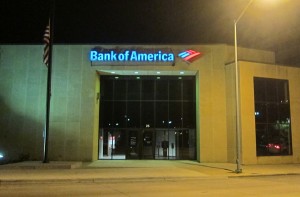 By Kirsten Valle Pittman and Gavin Off, The Charlotte Observer –
By Kirsten Valle Pittman and Gavin Off, The Charlotte Observer –
CHARLOTTE, N.C. — More than a year into a plan to shutter hundreds of branches across the country, Bank of America is eliminating more locations than any of its peers, from affluent big-city neighborhoods to rural areas.
(PHOTO: Bank of America in Mason City, Iowa.)
Nearly a third of the closures last year occurred in low- to moderate-income communities. And while that’s roughly in line with the percentage of such branches in the bank’s overall network, it worries some banking experts and consumer advocates, who say eliminating bank branches has a disproportionate effect on the poor and their neighborhoods, removing important community anchors and raising the cost of banking.
At a time when big banks across the country are stepping up efforts to cater to their most profitable customers, advocates worry that others could be left behind.
“The impact to the local economies could be devastating,” said Mark Williams, a former bank examiner who teaches at Boston University. “As banks pull out, banking needs of the poor do not disappear; these needs are simply picked up by predatory payday lenders and pawn shops.”
Bank of America said the closings, part of the efficiency initiative Project New BAC, will allow it to streamline expenses and better serve customers’ changing banking habits. The Charlotte-based lender is ramping up mobile and online offerings, enhancing existing branches and ridding its network of the duplication that resulted from decades of mergers.
Bank officials also say they continue to maintain — and add — more branches in low- to moderate-income neighborhoods than other big banks. Branches in those neighborhoods, where the household income is less than 80 percent of the geographic area’s median income, made up 27 percent of the bank’s total network at the end of 2011. That compares with 24 percent for Wells Fargo and 23 percent for JPMorgan Chase, data from the Federal Deposit Insurance Corp. show.
Since 2009, 38 of the 117 branches Bank of America has opened — about 32 percent — have been in those lower-income neighborhoods.
The nation’s second-largest lender by deposits has shed a net 262 banking centers since the beginning of 2011, according to its financial statements. A Charlotte Observer analysis of federal regulators’ branch closing data and U.S. Census figures found about 53 percent of those closings have occurred in neighborhoods whose median income lagged the countywide median.
Of those, about 17 percent occurred in areas where the household income was less than half of the county’s, the data show. The bank closed a branch in a neighborhood of Wilmington, N.C., last year, for instance, where the median income was just $16,100 per household, well below the $48,550 county figure.
Closures in low- to moderate-income neighborhoods, calculated by a different method under federal regulators’ guidelines, made up 31 percent of Bank of America’s branch closures in 2011, according to data the bank provided to regulators. The data weren’t available past the end of 2011.
Bank of America isn’t the only large lender to trim branches amid economic concerns, regulatory pressures and lingering duplication after a string of mergers and consolidations.
U.S. banks and thrifts closed more than 760 branches in the year ending June 30, the third straight year of declines after a long period of expansion, according to a report from banking research firm SNL Financial.
But Bank of America closed more branches than any other bank during that time, the researchers found. Its 157 net closures were more than double the level of the next company on the list, International Bancshares.
Wells Fargo, which bought Charlotte’s Wachovia in 2008, closed a net 44 branches in the same period, by comparison. JPMorgan Chase added 219.
Bank of America assembled one of the nation’s largest networks of branches through years of acquisitions, with U.S. banking centers peaking at more than 6,000 at the end of 2007 after it bought Chicago’s LaSalle Bank. It now has about 5,600 branches.
Consumer banking executive Katy Knox told the Observer that Bank of America is looking at its entire network to determine the “right number” of banking centers. That’s part of a multi-year plan to consolidate and sell branches, as well as invest in new and existing branches.
The bank plans to expand its coverage in top metropolitan areas and other places where it has a strong customer base and strong presence, she said. It’s also ramping up technology and services and adding specialists who can “serve as a bridge to refer people to other parts of the bank,” in some existing locations.







